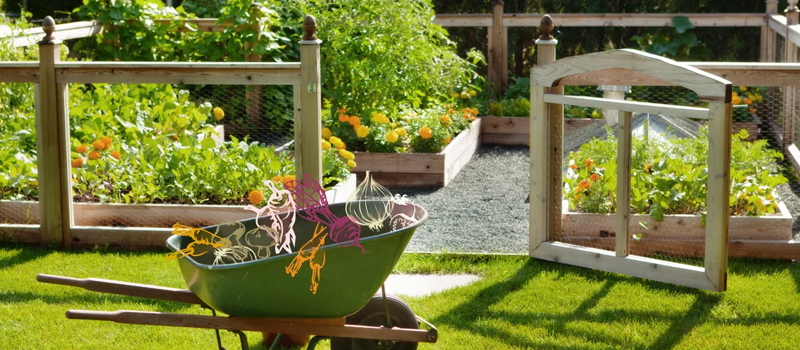For most parts of the US, this has been a banner year for storms, and precipitation that was sorely needed after years of drought. In fact, at the time of writing this we have several inches of snow that we are dealing with as we speak, When looking out over a snow-covered yard, the last thing you will probably think about is gardening.
 But it is in the Winter months for Permaculture Backyard gardens that is a wonderful time to start planning for your spring vegetable garden. You can look at what you have and decide if you want to keep it as it is, or try a new herb or vegetable. Now, we have plenty of “Planning Your Garden” articles on here and you can go search them out for the tips that have been placed there. This is a pull for the preparation that is needed when you seek to have your very own Food Security systems in your back yard. Winter gives you a good time to look at your yard area and decide how to set the garden up, where each plant will go, and what types of vegetables, herbs or companion plants you want to grow.
But it is in the Winter months for Permaculture Backyard gardens that is a wonderful time to start planning for your spring vegetable garden. You can look at what you have and decide if you want to keep it as it is, or try a new herb or vegetable. Now, we have plenty of “Planning Your Garden” articles on here and you can go search them out for the tips that have been placed there. This is a pull for the preparation that is needed when you seek to have your very own Food Security systems in your back yard. Winter gives you a good time to look at your yard area and decide how to set the garden up, where each plant will go, and what types of vegetables, herbs or companion plants you want to grow.
No matter what you wish to have – a tiny herb garden or a much larger vegetable garden – winter preparation is key to success. The more prepared you are come warmer weather, the more rewarding and fun it will be for you throughout the season. Although gardening does involve some hard work, having good healthy fun is best with all these Food System ideas. Here are a few steps to help you prepare during the cold months:
STEP NUMERO UNO:
Review what last year’s garden was like. Look at what worked well and what didn’t. What went gangbusters and what was a bust? How can you improve upon what you did last time to make it better/easier/more plentiful a harvest? If the reasons you find for the bust is fixable, now is the time to plan that solution and get it into place. Review the frost dates in your region. This will help you decide what plants to choose. You will need to become somewhat of a weather forecaster, farmer and prognosticator of the areas climate. This will help when you decide where to put your garden, and where certain plants will grow the best.
STEP DREI:
Next, Set into stone for the next season and label the areas you wish to plant certain herbs or vegetables for rhe next year. Keep in mind the spacing of seeds, the size of growing and mature plants, and the rotation of crops. The size of the area you have to plant will determine what you do or can get done. The larger the size makes it easier to rotate and organize. Sections are usually cruciferous veggies (which are cabbages, cauliflower and Brussels sprouts, for example), legumes (beans, peas), and rooted tubular crops (carrots, beets, potatoes and parsnips). The next part can be the vine-fruited types (melons, squash, tomatoes, etc). It is all depending on the work you put in now and what work you want to put in later. A good practice of rotating your plants every few (three or four) years can prevent pests and diseases from taking a foothold in your garden area.
STEP HAROM:
With things in place, you can turn your attention over and check onyour gardening tools. Have them repaired before spring if possible. Find supplies you will need and have them stocked before they get hard to find. This is the time to order seeds or plants. Also, it’s a great time to go to home and garden shows and visit botanical gardens. Look through some gardening magazines and expand your green thumb knowledge.
STEP FOUR:
As things start to thaw, if you are able to see your garden plot (i.e., if it’s not covered with snow), the cold weather is a good time to remove stones and look at the soil. Soil is important no matter what season it is. Winter is a good time to take care of it so it is ready to go in the spring. Determine what needs to be added to the dirt in the garden (addition of nutrients or subtraction of alkaline compounds, etc.) Grab a shovel and turn over the top 12 inches of soil; take organic material, either leaves, mulch, compost or manure (you may have to buy from a store), and put it on top. Once the soil is dry in the spring, grab your shovel and break it down again, until it is finely separated.
Overall TakeAway
Planning your spring garden now will also give you something to look forward to when those cold, wintry days are over. Getting started now will save you time and hard-earned money later. Remember, a good source for information are other dedicated backyard farmers that have been doing their food systems for a while, whether it be in person or online, get their input as well as to the what’s and wherefores for your area. It is a wonderful way to get ideas and participate in garden brainstorming, whether it be discovering new types of plants … or even deciding where to put that scarecrow of yours!






